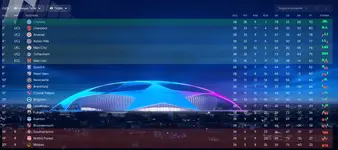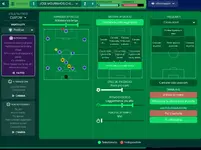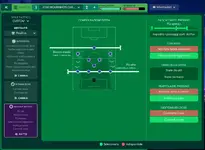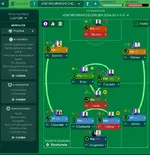fmcalciomaestro
Member
- Joined
- Jan 27, 2025
- Messages
- 16
- Reaction score
- 3
- Points
- 3
THE 2004-05 CHELSEA OF JOSE MOURINHO IN FOOTBALL MANAGER 2024
1. Introduction José Maria Felix Mourinho achieved the incredible feat of winning the UEFA Champions League with Porto in 2004, defeating another surprise finalist, the French side Monaco. This success earned him a call from Chelsea's owner, Russian billionaire Roman Abramovich, who entrusted him with the Blues' bench for the 2004-05 season. The ambitious English club was eager to finally win the Premier League after finishing second under Claudio Ranieri. The squad available to Mourinho was undoubtedly strong, though perhaps not the best in England at the time.
In goal, there was the Czech Petr Čech, who was still at the beginning of his extraordinary career. The defense consisted of Portuguese right-back Paulo Ferreira, signed from Porto, alongside right-center back Ricardo Carvalho. The left-center back was John Terry, who would go on to become one of England’s greatest defenders and Chelsea's captain. Wayne Bridge played as the left-back.
Mourinho's three-man midfield was a major tactical innovation in the Premier League, which was still largely dominated by the 4-4-2 formation. Even teams with variations, like Arsène Wenger’s Arsenal, often transformed their setup into a 4-2-3-1 in possession. The Chelsea midfield trio caused significant problems for opponents, who were frequently outnumbered in the most crucial area of the pitch—where losing possession could be highly dangerous.
Mourinho is also credited with transforming Frank Lampard into one of England's greatest midfielders, giving him the freedom to push forward, create plays, and utilize his excellent passing and long-range shooting abilities. Covering behind him were two outstanding defensive midfielders: Frenchman Claude Makélélé, an irreplaceable ball-winner and shield in front of the defense, and Ghanaian Michael Essien, a dynamic workhorse on the right who contributed both defensively and offensively.
The attacking trio featured the Dutch winger Arjen Robben, who would start wide before cutting inside with the ball at his feet to shoot from distance or play a through pass. Even though his moves were predictable, his speed made him nearly unstoppable. On the opposite flank, a more traditional winger, Damien Duff (sometimes replaced by Joe Cole), focused less on shooting and more on penetrating the box with or without the ball. Leading the attack was Didier Drogba, the Ivorian striker who became one of Africa’s greatest players alongside Samuel Eto’o and George Weah. Drogba used his immense physicality to battle opposing defenders and hold up the ball for his teammates. If opponents pressed high to prevent Chelsea from building from the back, Čech or the center-backs would launch long balls to Drogba, who consistently won aerial duels and laid the ball off to advancing midfielders, bypassing the press.
Defensively, Chelsea formed a 4-5-1 shape, with the wingers dropping back alongside the three midfielders in a compact mid-block that prevented opponents from exploiting spaces between the lines. With two dominant aerial defenders in Terry and Carvalho, Chelsea was comfortable defending crosses and often forced opponents wide to limit central attacking opportunities. In possession, Chelsea preferred to build from the back, though Čech was minimally involved, usually making short passes to the center-backs. If opponents pressed aggressively, long balls to Drogba were an alternative. The full-backs played wide, with Paulo Ferreira pushing forward more frequently than Bridge, who had a more defensive role but still contributed in possession.
Chelsea’s attacking play was characterized by vertical passing when possible; otherwise, they circulated short passes, waiting for gaps to open in the opposition’s half. When space emerged, midfielders made runs and were picked out through balls. The wingers stayed wide, using their dribbling ability to create one-on-one situations and numerical superiority.
Now, let’s examine Chelsea’s tactical setup and individual player instructions in Football Manager 2024.
T
I tested this tactic in just one season with Chelsea without buying or selling any players. I won the Premier League (93 points, 28 wins, 9 draws, 1 loss, 78 goals scored and 23 conceded) and the UEFA Conference League, being eliminated in the semifinals of the FA Cup and Carabao Cup by Manchester City.
More details and stats here
1. Introduction José Maria Felix Mourinho achieved the incredible feat of winning the UEFA Champions League with Porto in 2004, defeating another surprise finalist, the French side Monaco. This success earned him a call from Chelsea's owner, Russian billionaire Roman Abramovich, who entrusted him with the Blues' bench for the 2004-05 season. The ambitious English club was eager to finally win the Premier League after finishing second under Claudio Ranieri. The squad available to Mourinho was undoubtedly strong, though perhaps not the best in England at the time.
In goal, there was the Czech Petr Čech, who was still at the beginning of his extraordinary career. The defense consisted of Portuguese right-back Paulo Ferreira, signed from Porto, alongside right-center back Ricardo Carvalho. The left-center back was John Terry, who would go on to become one of England’s greatest defenders and Chelsea's captain. Wayne Bridge played as the left-back.
Mourinho's three-man midfield was a major tactical innovation in the Premier League, which was still largely dominated by the 4-4-2 formation. Even teams with variations, like Arsène Wenger’s Arsenal, often transformed their setup into a 4-2-3-1 in possession. The Chelsea midfield trio caused significant problems for opponents, who were frequently outnumbered in the most crucial area of the pitch—where losing possession could be highly dangerous.
Mourinho is also credited with transforming Frank Lampard into one of England's greatest midfielders, giving him the freedom to push forward, create plays, and utilize his excellent passing and long-range shooting abilities. Covering behind him were two outstanding defensive midfielders: Frenchman Claude Makélélé, an irreplaceable ball-winner and shield in front of the defense, and Ghanaian Michael Essien, a dynamic workhorse on the right who contributed both defensively and offensively.
The attacking trio featured the Dutch winger Arjen Robben, who would start wide before cutting inside with the ball at his feet to shoot from distance or play a through pass. Even though his moves were predictable, his speed made him nearly unstoppable. On the opposite flank, a more traditional winger, Damien Duff (sometimes replaced by Joe Cole), focused less on shooting and more on penetrating the box with or without the ball. Leading the attack was Didier Drogba, the Ivorian striker who became one of Africa’s greatest players alongside Samuel Eto’o and George Weah. Drogba used his immense physicality to battle opposing defenders and hold up the ball for his teammates. If opponents pressed high to prevent Chelsea from building from the back, Čech or the center-backs would launch long balls to Drogba, who consistently won aerial duels and laid the ball off to advancing midfielders, bypassing the press.
Defensively, Chelsea formed a 4-5-1 shape, with the wingers dropping back alongside the three midfielders in a compact mid-block that prevented opponents from exploiting spaces between the lines. With two dominant aerial defenders in Terry and Carvalho, Chelsea was comfortable defending crosses and often forced opponents wide to limit central attacking opportunities. In possession, Chelsea preferred to build from the back, though Čech was minimally involved, usually making short passes to the center-backs. If opponents pressed aggressively, long balls to Drogba were an alternative. The full-backs played wide, with Paulo Ferreira pushing forward more frequently than Bridge, who had a more defensive role but still contributed in possession.
Chelsea’s attacking play was characterized by vertical passing when possible; otherwise, they circulated short passes, waiting for gaps to open in the opposition’s half. When space emerged, midfielders made runs and were picked out through balls. The wingers stayed wide, using their dribbling ability to create one-on-one situations and numerical superiority.
Now, let’s examine Chelsea’s tactical setup and individual player instructions in Football Manager 2024.
I tested this tactic in just one season with Chelsea without buying or selling any players. I won the Premier League (93 points, 28 wins, 9 draws, 1 loss, 78 goals scored and 23 conceded) and the UEFA Conference League, being eliminated in the semifinals of the FA Cup and Carabao Cup by Manchester City.
More details and stats here
Attachments
-
 CLASSIFICA.webp112.9 KB · Views: 258
CLASSIFICA.webp112.9 KB · Views: 258 -
 COMPETITIONS.webp166.9 KB · Views: 75
COMPETITIONS.webp166.9 KB · Views: 75 -
 IN POSSESSION.webp70.5 KB · Views: 64
IN POSSESSION.webp70.5 KB · Views: 64 -
 IN TRANSITION.webp63.9 KB · Views: 56
IN TRANSITION.webp63.9 KB · Views: 56 -
Jose Mourinho's Chelsea 04-05 4-3-3 tactic emulation.fmf41.2 KB · Views: 29
-
 OUT OF POSSESSION.webp60.6 KB · Views: 115
OUT OF POSSESSION.webp60.6 KB · Views: 115 -
 OVERVIEW.webp66.3 KB · Views: 126
OVERVIEW.webp66.3 KB · Views: 126